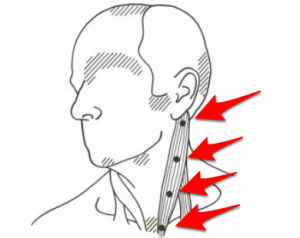The massage client who can’t turn the head, the headache that arcs over the ear to the ridge of the eyebrow, the sensation of steel cables squeezing the anterior neck: These are all signs of those darn sternal-cleido-mastoids.
We massage therapists see these symptoms frequently, and I have made a hobby of asking other therapists how they try to free the dreaded SCMs. There must be dozens of techniques, dozens of approaches, and yet I still seek one method that won’t make a client levitate.
Lucky for us, clients with taut SCMs are so miserable they will tolerate our  fingers making an attempt to unwind these two-headed sticklers. They will try anything to get the eyebrow to stop pounding.
fingers making an attempt to unwind these two-headed sticklers. They will try anything to get the eyebrow to stop pounding.
My first experience with unlocking SCMs was with a fairly invasive technique I learned in school: Lifting the sternal and clavicular heads of the SCMs together, on one side, and sifting the TrPs between thumb and forefinger, careful to exclude the pulsating nearby artery.
Well, that does work, but my experience with clients leaving skid marks led me to believe it might be better to learn a softer approach.
It does help to lift the head and shorten the side being palpated by turning the head to the opposite side. An MFR technique I tried to lengthen the SCM from short to long with pincing fingers also left me cold. If the client has any fear of neck constriction, this technique will make it a full-blown phobia.
One time I encountered a client who had survived an attempted strangulation. These SCMs had gone over the moon to protect her. There was no way in heck I was going to lift, sift or pince while twisting.
A class with Erik Dalton saved my hands on that one. He showed, with his usual complete relaxation, a non-threatening way to cross one hand over the front of the neck, palpating the anterior edges of the SCMs with soft finger-pads. The other hand, from behind the head, brought soft finger-pads to the posterior side. A few moments of light touch and patience, the SCMs unwound. No twisting necessary, and no skid marks.
Believe me, that client was able to enjoy a good night’s sleep for the first time in a long time.
What about the chronic phone holder? With today’s tiny phones, and with the old-timey, clodhopper phone handsets, many people have ground in one tight SCM. This pattern creates one-sided headaches and can persist for years. Enough stress and people come in looking like they are holding an invisible violin in their neck.
Well, when challenged, I look to topical magnesium lotions to help. Magnesium oil from seawater stings cut skin so it can be used only if the area has not been shaved. Otherwise, Epsom lotion. A light coating and then leave the client with that side in a light stretch while doing arms and legs.
By the time I return to the neck (20 or 30 minutes) the SCM at least knows it can stretch. If it lets me, I will do whisper-light TrP release on the surface followed by lymphatic circles toward the thoracic duct at the clavicular notch. You don’t have to get fancy, however, light Swedish in direction of the duct works also.
I send clients home with instruction not to turn quickly or whip their heads to either side. Use a little heat if sore. And hold the phone to an ear only looking straightforward and holding the phone in the opposite hand.
There are probably a many more good SCM secrets out there. Anyone?




